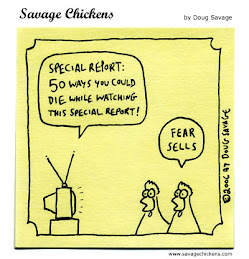Glassner, Barry. Culture of Fear: Why Americans are Afraid of the Wrong Things. New York: Basic Books, 1999.
Very good source with helpful references and index. 276 pages.
This book goes beyond the obvious and digs deep into television's many effects on Americans’ fears. Glassner uses specific news stories to prove that stories are often exaggerated or told incorrectly. Case stories and extensive research are evidence that television has a role in creating magnified fears of child molesters, cyberpredators, teen gambling, and even black men.
Altheide, David L. Creating Fear: News and the Construction of Crisis. New York: Aldine de Gruyter, 2002.
Excellent source with substantial references and useful index. 223 pages.
This insightful source highlights the nature of fear in our lives and argues that the media magnifies our “lens of fear,” or our fear-tainted view of the world. It narrows in on how particular organizations such as the military, television interviewers, and newspapers capitalize on spreading fear. Altheide explains that the use of fear as entertainment cause the growing perception that the world is hazardous, violent, and unsafe.
Singer, Dorothy G. and Jerome L. Singer. Handbook of Children and the Media. Thousand Oaks: Sage Publications, Inc., 2001.
Excellent source with extensive bibliography and index. 765 pages.
This text is very straightforward and easy to navigate. The authors support their information about televisions and their effects with statistics and psychological experiment results. Especially relevant are the chapters “Effects of Televised Violence on Aggression” and “The Media and Children’s Fears, Anxieties, and Perceptions of Danger.” The former gives useful background information about the influence of television on Americans. The latter delves into the psychological impact of television on children and uncovers the role media plays in children’s worries and anxieties.
Howe, Michael J. Television and Children. London: New University Education, 1997.
Insightful source with useful bibliography and index. 157 pages.
As a psychologist, Howe has a lot to offer on the topic of television’s effect on children. His text draws a useful connection between television and learning. He describes children as John Locke would: savages with no knowledge of their society’s culture, or a blank slate. He asserts that television as a large component of children's’ learning about the world and culture and defines three ways that television effects viewers: effects on behavior, effects on knowledge, and effects on attitudes.
Radford, Benjamin. Media Mythmakers: How Journalists, Activists, and Advertisers Mislead Us. New York: Prometheus Books, 2003.
Outstanding source with extensive bibliography and index. 324 pages.
This text provides a revealing look at the news and its motives. Chapter 3, “The News Bias,” is particularly useful because it provides background statistics that show that the news reports a disproportionate amount of crimes, leaving other important topics, such as education and health care, underrepresented. The effect of biased and disproportionate news is that people fear crime and tragedies more than they should.







No comments:
Post a Comment